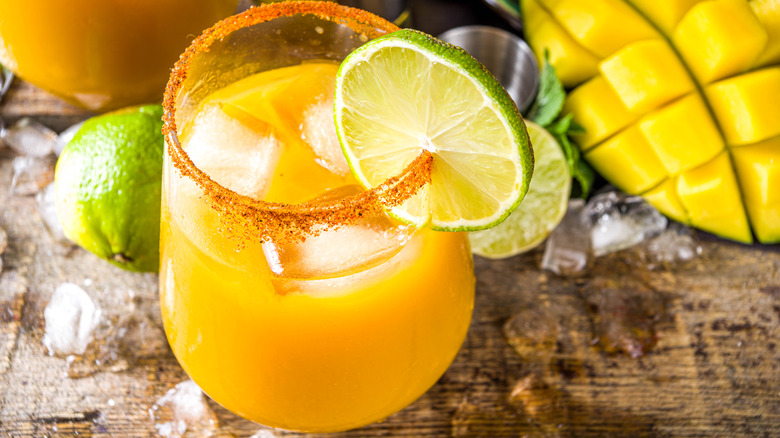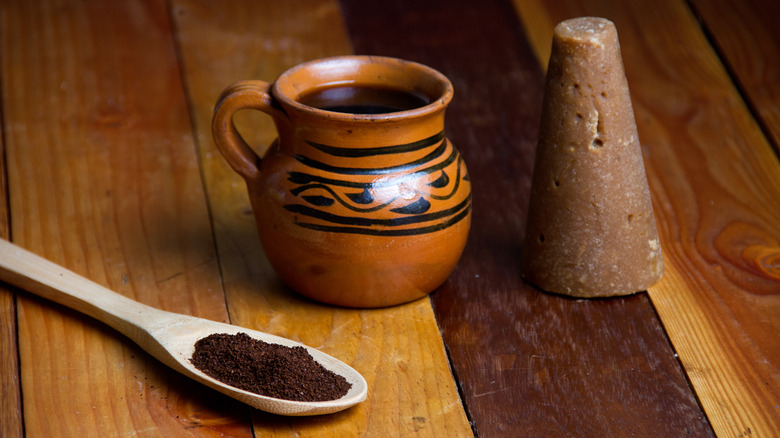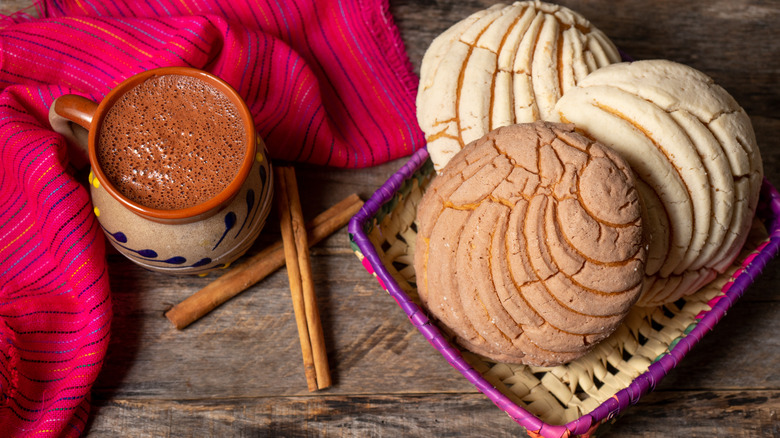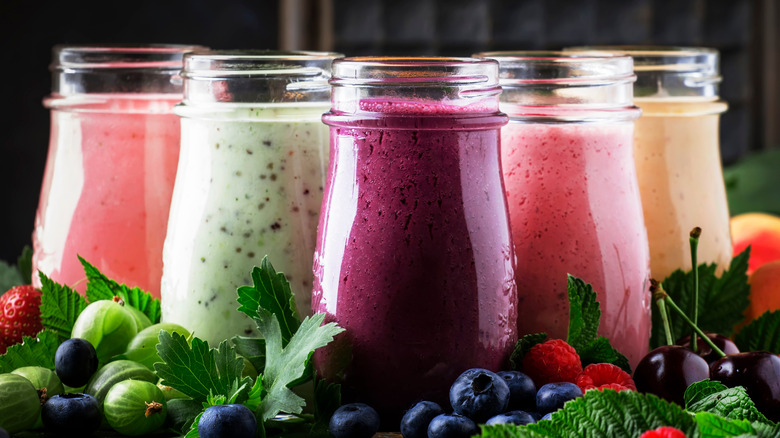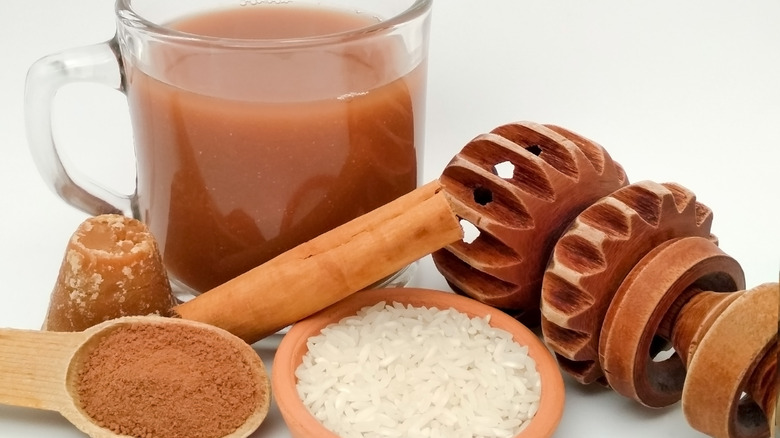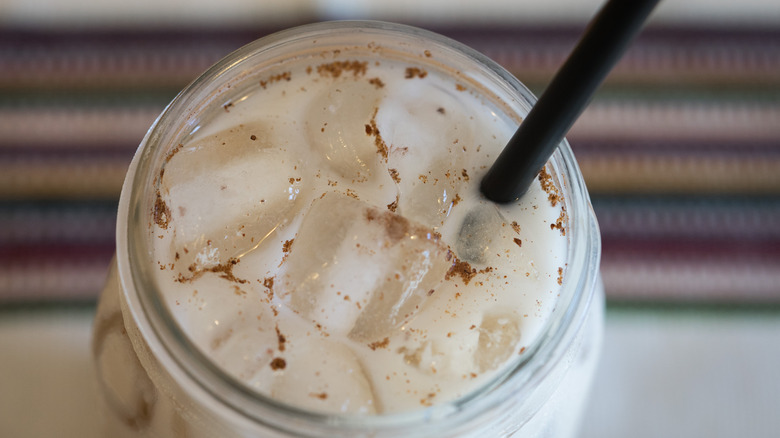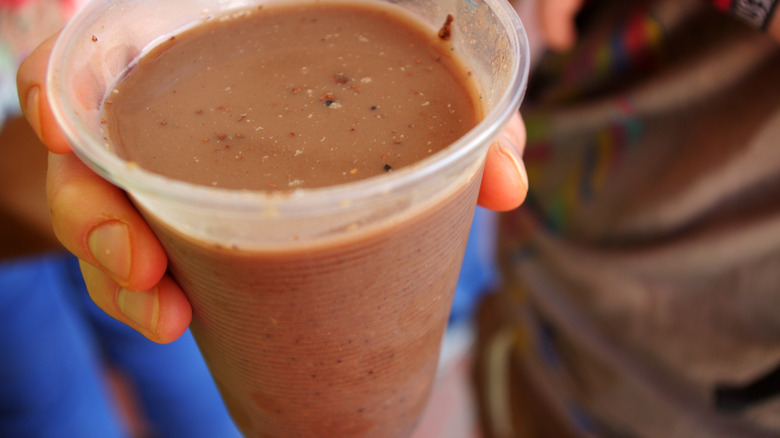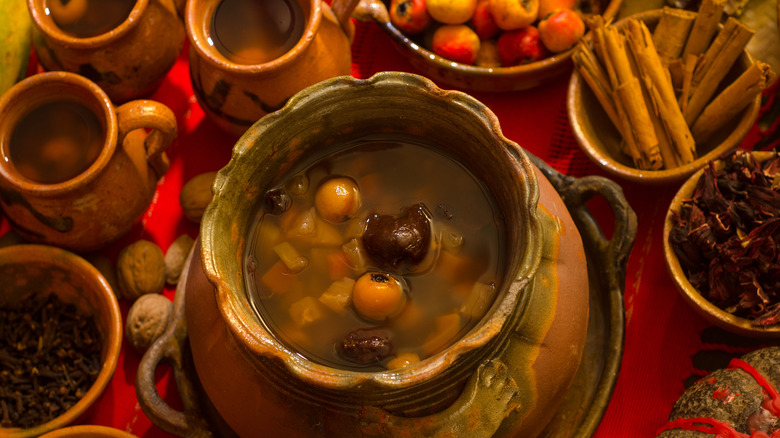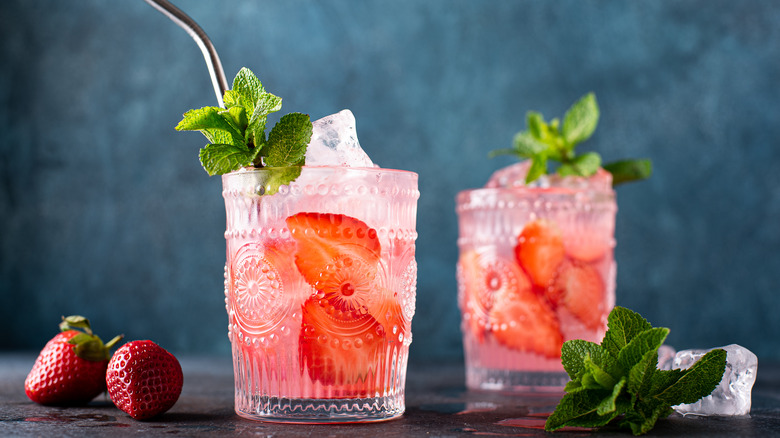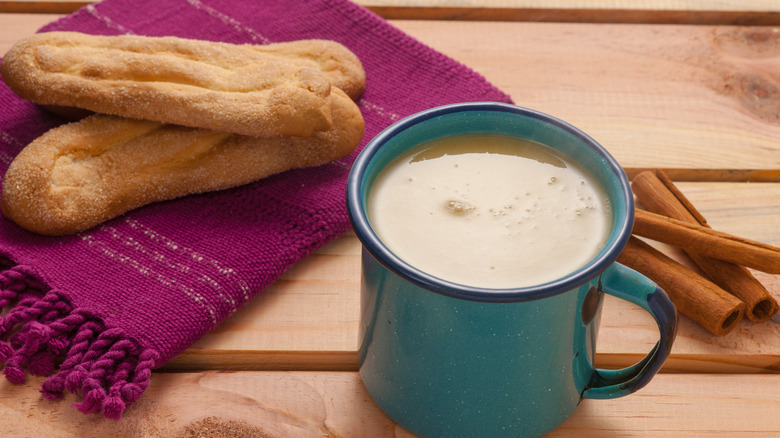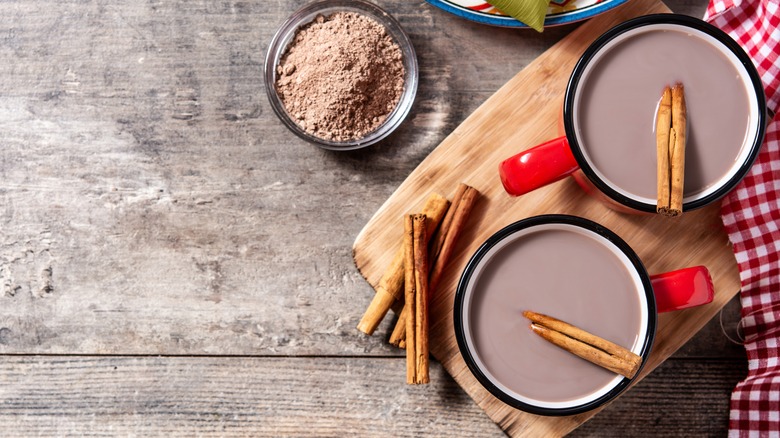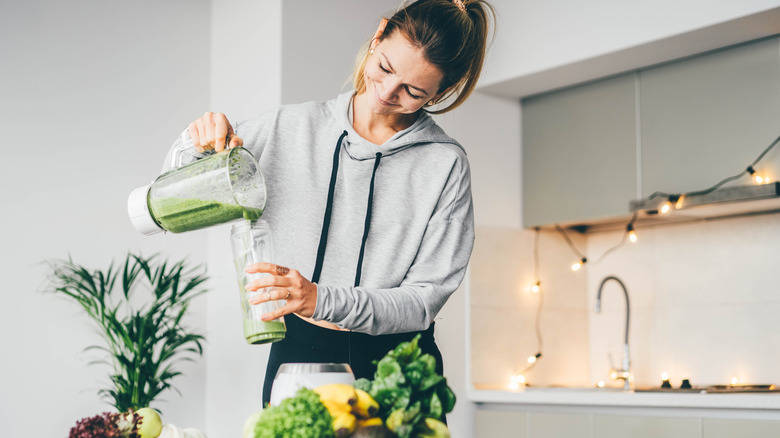Non-Alcoholic Mexican Drinks You Can Make At Home
We may receive a commission on purchases made from links.
Margaritas or tequila shots probably spring to mind when you think about Mexican drinks. However, Mexico is home to many delicious non-alcoholic beverages that you can make in your kitchen. You'll find options for summer days, getting cozy on the couch, or for celebrations with those near and dear. Best of all, many of these drinks pack a punch of healthful benefits as they refresh.
Drinks in Mexico are often colorful, but another hallmark is texture. While texture might seem an odd component in a beverage, it can add substance and interest to a beverage. Mexican drinks can be sweet, sour, or savory, and some include ingredients like masa, rice, fruits, and vegetables that lend texture. Many of these drinks are centuries-old, and some have been used by indigenous people on long journeys when food might be scarce. Some are considered a drinkable snack or light breakfast, but no matter which you try, we bet you'll find them delicious. Read on to expand your horizons beyond Jarritos.
Café de olla
Café de olla, sometimes called Mexican coffee, is sweet and spicy coffee brewed with piloncillo and cinnamon. Piloncillo is a hard brown sugar made by boiling sugarcane stalks into a thick syrup molded into discs, bricks, or cones. It's less refined than brown sugar, and it, along with cinnamon, gives café de olla its signature flavor.
Traditionally brewed in a clay pot known as an olla, it's made by allowing coffee grounds, cinnamon, and piloncillo to simmer in water. If you'd like to try your hand at the traditional preparation, combine water, a cinnamon stick, and piloncillo to taste and heat until the sugar dissolves. Add coarsely ground coffee (for easy straining) and stir. Turn off the heat and cover, then let the coffee steep for about five minutes before straining and serving.
Some recipes add orange peel or star anise to the brew, while some call for Mexican chocolate. You can substitute brown sugar for piloncillo, but since it's easy to find at any store that carries international products, we say it's worth buying.
Mexican hot chocolate
Everyone loves hot chocolate, but it's made in a unique way in Mexico. Mexican hot chocolate doesn't use cocoa powder for its chocolate flavor. Instead, chocolate disks (known as table chocolate) are melted right into the milk, then frothed to make a signature foamy topping (via The Spruce Eats).
Table chocolate is easy to find anywhere international food is sold. Though it might be tempting to chop up any chocolate you have on hand, don't — traditional Mexican hot chocolate demands the real thing. Table chocolate contains cinnamon and sugar, so taste before adding extra sugar. Although Mexican chocolate is known for leaving a chocolate slurry on the bottom of the cup, that's part of the charm.
Mexican hot chocolate is also famous for its depth of flavor, which comes from cinnamon and occasionally other seasonings like vanilla. Sometimes a dash of chili powder or cayenne pepper makes it spicy. In Mexico, hot chocolate is served with bread for dunking and might serve as a breakfast, a snack, a light dinner, or a holiday treat. Mexican hot chocolate is a welcome upgrade over the powdered stuff, whether you like your chocolate spicy or sweet.
Licuados
Licuados are popular in Mexico and throughout Latin America. Sometimes called batidos, they are made by blending fruit, milk, sugar, and cinnamon and are a popular quick breakfast either made at home or bought from street vendors. They are refreshing and light, especially during hot weather. While in some ways licuados are similar to milkshakes, they have a thinner consistency and don't use ice cream.
Traditionally, licuados are made from bananas, whole milk, plenty of brown sugar, and cinnamon (via Mexican Food Journal). As they gained popularity throughout Latin America and eventually the United States, using all sorts of fruits and vegetables became the norm. Try mangoes, berries, pineapple, peaches, papaya, and watermelon, or if you need to up your veggie intake, a handful of spinach, kale, celery, or cucumbers will do. Not a fan of cow's milk? Substitute coconut, soy, oat, or almond milk according to your preferences. For a thicker licuado, you can use frozen fruit, substitute Greek yogurt for the milk, or blend ice into the drink. Adding protein powder, some oats, or nut butter can make licuados more filling and add a punch of nutrition (via De Las Mías).
If you're looking for a delicious healthy breakfast or snack, try different fruit and add-ins to discover your perfect licuado.
Chilate
Chilate, an ice-cold drink popular in Mexico,is made from rice, roasted cacao beans, cinnamon, and brown sugar, according to Culture Trip.
Chilate is traditionally prepared with roasted cacao beans ground to a powder, added to rice soaked with cinnamon, and then combined with brown sugar to form a paste (via Taste Atlas). Water is added to the desired consistency, and then the drink is poured repeatedly between pitchers to froth it, then poured over ice to serve.
Although most of us have probably never roasted cacao beans, it isn't as hard as it seems. You can use a cast iron pan in the oven. If you can't find cacao beans to roast, they're easy to find online. Be aware that chilate takes a bit of planning because the rice needs to soak overnight. If you feel adventurous, experiment with extra spices like pepper. ginger, or anise, but always pour chilate over ice to enjoy a taste of Mexico in your kitchen.
Horchata
Horchata didn't originate in Mexico but is a truly global phenomenon. It was first found in ancient Rome and Africa; it became popular in Spain before spreading into Latin American countries. In Africa and Spain, horchata is made with tiger nuts, while rice is used in Mexico. No matter which ingredients are used, horchata's sweetness makes it perfect for dessert, breakfast with bread or pastry, or to balance out spicy meals.
You'll need to plan since horchata uses soaked rice, but it's worth waiting for. Our easy horchata recipe calls for soaking rice and almonds in water overnight.
After blending and straining the soaked rice, add evaporated milk and condensed milk, plus cinnamon and vanilla to make it creamy and sweet. If you omit condensed milk, you'll need to add some sugar to the drink. You may, of course, use plant-based milk like almond, coconut, soy, or oat milk. Experiment with the amount of milk and flavorings to find your perfect horchata, but remember to garnish it with a dusting of cinnamon and serve it over ice.
Agua de avena
Any fans of horchata must try agua de avena. Also known as oatmeal horchata, it uses the same principles of soaking, blending, straining, and flavoring to make a light, refreshing drink that works for breakfast, a snack, or cooling the tongue when eating a spicy meal (via M.A. Kitchen).
Agua de avena is not only thirst-quenching — it delivers a shot of nutritional goodness, thanks to oatmeal. Oats have plenty of vitamins, minerals, and fiber. To make agua de avena at home, soak a cup of oatmeal for at least 30 minutes in water with a cinnamon stick or powdered cinnamon to taste. After soaking, pour into a blender and process until thick. Strain the mixture and discard any solids left behind for an extra-smooth base. Add brown sugar and vanilla to taste and mix till frothy.
Here's where personal taste comes in. The base of agua de avena is traditionally thinned with enough water to make a pitcherful. If you crave an even creamier taste, use milk or plant-based alternatives – it's delicious with oat, coconut, soy, or almond milk. You can also use different sweeteners to change the flavor or lower the calorie count, like honey, agave, white sugar, or the sugar substitute of your choice. Agua de avena may take a bit of time and effort, but one taste, and it's worth it.
Pozol
Pozol is another traditional Mexican drink that is a drink and a light snack all in one. Indigenous people made pozol with fermented corn dough because there was no fear of spoilage while walking long distances in the heat (via Vamonos to Mexico). This dough was enriched with cocoa and sometimes included salt and chilis to deepen the flavors. Some variations include honey, milk, or sweet potato. Today, street vendors sell this chocolatey treat over ice, decorated with edible flowers.
Dixie Crystals has a recipe for a quick, un-fermented version of pozol that's easy to whip up at home. For the dough, combine masa with cocoa in a bowl and add warm water until you form a dough ball that isn't sticky. Wrap in plastic to store. Next, make the sugar syrup by simmering equal parts water and brown sugar and whisk till thickened. Add cinnamon and vanilla to the syrup and pour into a jar to store in the refrigerator.
Enjoy pozol any time you want a snack or for a dessert drink. Cut some masa dough into small pieces and add to a blender with cold water, mixing till dissolved and frothy. Add sugar syrup to taste and mix again. Serve poured over ice for a velvety chocolate drink that brings dreams of a trip to Mexico.
Ponche
Mexican ponche, also called ponche Navideño, is a Christmas favorite in Mexico, but this hot spiced fruit punch is delicious no matter the season. It's similar to sangria but is non-alcoholic (unless you choose to add rum). One of the nicest things about ponche is simmering it on the stove to fill the house with a delicious bouquet of cinnamon and citrus.
Per Mexico in my Kitchen, traditional ponche is spiced with cinnamon, tamarind, hibiscus flowers, and cloves, though some add anise and chamomile. The spices can be simmered in water and piloncillo (or apple cider) while the fruit is prepared. In Mexico, a mixture of fresh and dried fruit is preferred and always includes guavas and tejocotes, the tiny sweet and sour fruit of the Mexican hawthorn. Apples, pears, and oranges are popular additions, with raisins and prunes the dried fruit of choice. You can buy guava and tejocotes canned in syrup in some Latin America grocers, so don't be put off by harder-to-find ingredients. Some cooks also like limes and pineapple; ponche is customizable to whatever you have on hand.
To make ponche at home, you'll need a gallon of water or cider in a big stockpot. Bring it to a low boil while you wash and chop the fruits you want to use, then simmer at least an hour before serving. Include some fruit in every mug, and don't forget to use cinnamon sticks as stirrers – they look pretty and add tons of flavor.
Agua fresca
Agua fresca means fresh water in Spanish, making it the perfect name for the natural, cooling Mexican drink that blends combinations of fruit (and sometimes other ingredients) with water. These drinks complement any meal, use whatever fruit you have on hand, and are refreshing in hot weather. Citrus agua frescas can be made by squeezing the juice out of the fruits, but most aqua frescas are made by mixing fruit with sugar and water in a blender, often with some lime juice.
Popular fruits for agua fresca are pineapple, oranges, apples, mangoes, watermelon, and berries (via The Spruce Eats). Agua Jamaica uses hibiscus flowers steeped like tea before mixing into the water, lime, and sugar base. Tamarind is another popular agua fresca flavor. It's pretty labor-intensive to work with whole tamarind pods, but fortunately, it's pretty easy to find canned tamarind pulp. Feel free to experiment with different fruits to find your favorite combination, and enjoy an authentic Mexican favorite.
Atole
Atole is a creamy, hot drink served for breakfast or enjoyed as a snack. It's most often made with masa harina, the cornflour used for tortillas; some variations use oatmeal, rice, or wheat flour (via the Spruce Eats). Other cooks prefer using cornstarch or cornmeal, but whichever way you make atole, the texture should be smooth, with a lush mouthfeel. Atole is easily made at home, and in Mexico, it's easy to buy on the go from street vendors. Although it's considered a drink, some enjoy serving it like soup because it stays so hot that using a spoon can protect you from burning your mouth.
Traditionally, atole was made with water, but now most make it at least partly with milk. Basic atole is flavored with cinnamon and vanilla, though there are also flavored atoles. Piloncillo is the traditional sweetener, but you can substitute brown or white sugar, honey, agave, or low-calorie sweetener.
To make atole at home, heat the milk/water combination you like with sweetener to taste, stirring often until it simmers. Meanwhile, whisk masa together with hot water until a smooth slurry forms. Making sure there are no lumps, slowly add it to the heated milk, constantly whisking for a minute or two. Add cinnamon and vanilla and combine before tasting to adjust sweetness and seasoning. Serve in mugs (or bowls), dusted with cinnamon. Leftovers may be stored in the refrigerator and reheated.
Champurrado
Champurrado is the chocolate version of atole. It is like thick, creamy hot chocolate enriched with cinnamon, but don't confuse it with Mexican hot chocolate. Champurrado, like atole, is thickened with masa (via Isabel Eats). While champurrado and Mexican hot chocolate are both enjoyed for a light breakfast or snack time, champurrado is more filling than regular hot chocolate.
Champurrado, like atole, is made by heating milk and sugar, then adding a slurry of masa and cooking until thickened, and then seasonig with cinnamon and vanilla. Most recipes for champurrado call for Mexican chocolate, or table chocolate, while others use cocoa powder. The table chocolate can be chopped and melted into the milk and sugar before adding the masa slurry and thickening the drink.
Once the masa slurry is added, continue cooking till the champurrado boils, then turn the heat down and allow it to thicken, whisking often. Add cinnamon, vanilla, and a tiny pinch of salt to enhance the chocolate flavor. For an extra taste of Mexico, try adding cloves and some orange zest and enjoy this decadent chocolate treat (via Mexico In My Kitchen).
Jugo verde
Jugo verde means green juice in Spanish, and it perfectly describes this healthy Mexican breakfast favorite. Jugo verde has been popular in Mexico far longer than current trendy detox smoothies, but the principle is the same. Jugo verde can be strained or left pulpy based on personal preference, but whichever way you drink it, its health benefits are apparent, and it's an easy and delicious way to eat more veggies (via Sprint Kitchen).
Traditionally, jugo verde is made with nopales, a variety of prickly pear cactus full of vitamins and antioxidants. Nopales are sold in the refrigerated produce section and might be called cactus paddles. They are sometimes sold whole but are often trimmed, diced, and bagged for sale. If you can't find them or don't want to try them, Sprint Kitchen recommends celery as a substitute.
As for other jugo verde ingredients, pineapple, oranges, parsley, and cucumbers are often added with nopales for a refreshing, tropical flavor. However, what you add is up to your taste and what you have on hand. Many people like to add greens, like spinach, kale, and chard. Apples, mangoes, kiwi, grapes, and berries are common additions, and if you don't have parsley, try cilantro or basil to add a zesty flavor. Jugo verde may be made in a blender or juicer, whichever you have. Start any day on the right foot with jugo verde, even if you aren't buying it from a vendor in sunny Mexico.
